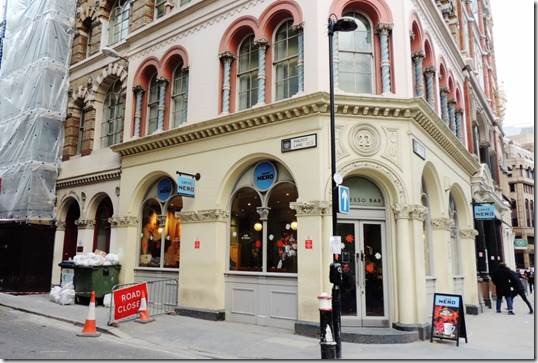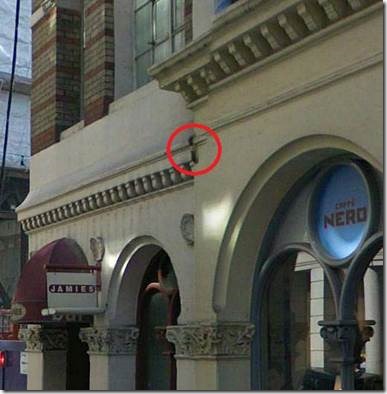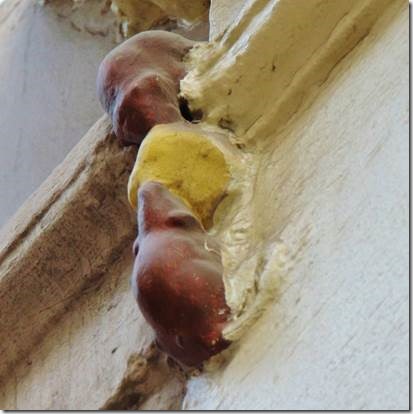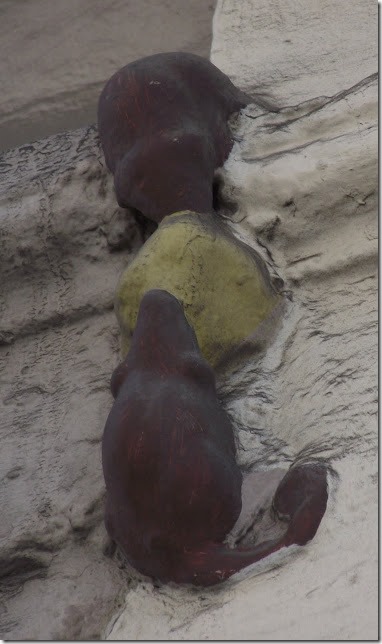Cheers,
So, how ‘bout them Pats? I don’t faithfully follow Patriots football and I’m not a Tom Brady fan, but my friend Bruce has season tickets so I’m very happy for him.
The third stop on our Square Mile tour was St. Dunstan-in-the-East. Most of the “already ailing” church was damaged so heavily in the blitz that it was not rebuilt. However, the “Wren” tower still remains and the open space has been designed into a city garden with an “insect hotel.” The Wren alternative medicines clinic is now located in the small building in the garden just next to the tower. I’ve put “Wren” in quotes as no one is absolutely sure how much input Christopher Wren had with all of these towers as he was very busy with the rebuilding of St. Paul’s Cathedral. Kathy, the church watcher I met at St Mary-at-Hill says they now use the phrase “the Christopher Wren influenced church.” I still have a few unanswered questions about St. Dunstan tower and garden, but for now, I’m done. It’s not the best time for garden visits, and I’m no flower or tree expert, so I can’t point out the Virginia Creeper or the Drimy Winteri mentioned in the information about the garden. But it is a lovely space for a quite sit or brown bag lunch.
While I was reading about St. Dunstan I learned there were British kings named Eadred, and Eadwig. Who knew? And in case you were going to ask, there is a St. Dunstan-in-the-west. (Like the witches in the Wizard of Oz.) http://www.stdunstaninthewest.org/ is a place I might have to visit for one of their lunch time recitals. Many churches offer these lunchtime treats; I attended one at St. Olave just near here.
Ru
“You really will feel secluded in this gem of a City Garden. Those with green fingers will appreciate the range of plants wending their way around the ruins: the walls and majestic windows have been draped and decorated over time with virginia creeper and ornamental vine, vitis coignetiae, which turns crimson in the autumn. Exotic plants such as the pineapple-scented Moroccan broom, cytisus battandieri, and the new zealand flax, phormium both thrive here in the sheltered conditions. An unusual plant in the lower garden is winter’s bark, drimy winteri. Its leaves are high in Vitamin C and were once eaten to prevent scurvy. Near to the fountain is a japanese snowball, viburnum plicatum, whose blossom in late spring is breath-taking.
Biodiversity
A beautiful tucked away green space of high ecological value with climbers adorning the historic walls and wildlife including robins and great tits are among the regular visitors to the site. Look out for the winning Insect Hotel built within the garden as part of the 2010 Beyond the Hive competition.”
Published:10 May 2012 Last Modified:07 November 2013
www.cityoflondon.gov.uk
|
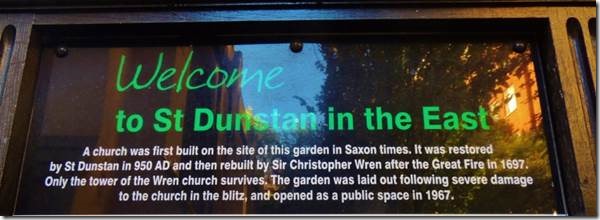
Information about St. Dunstan and the church follow the photos.
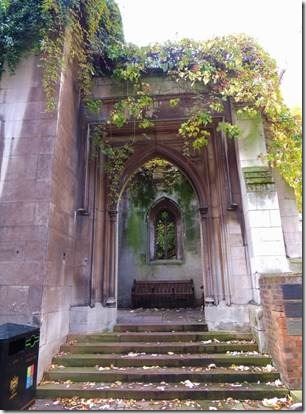 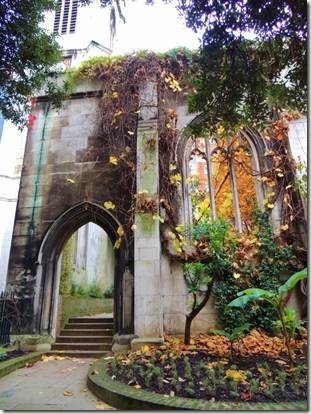
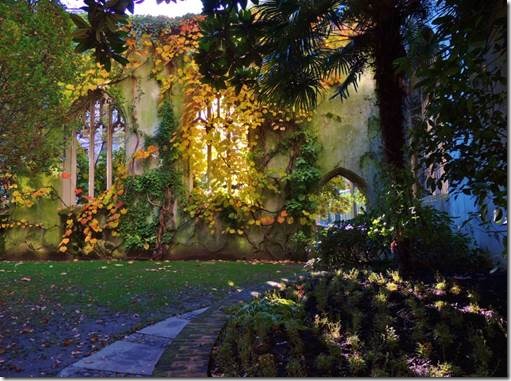
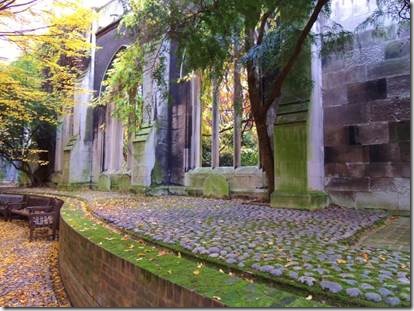
|
|
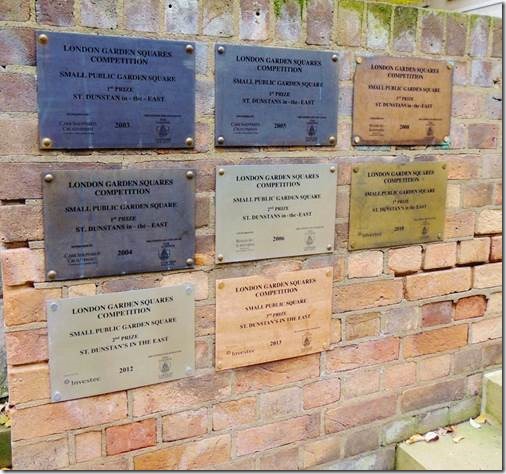
London Garden Square Competition awards over the years.
|
|
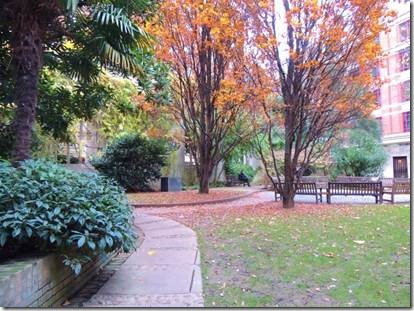
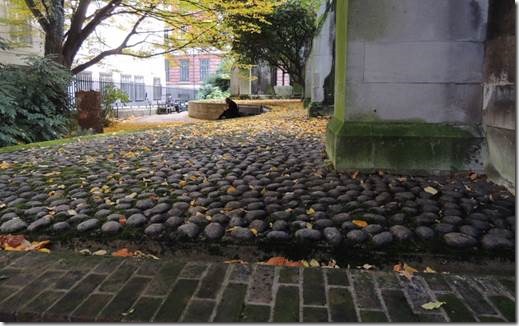
|
|
Insect hotel
“Two legs good, six legs better!”
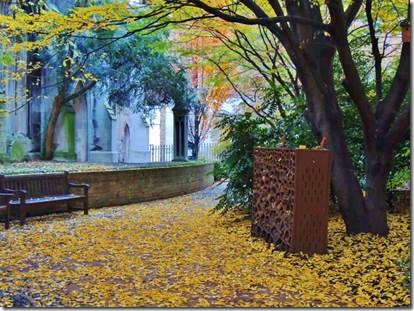
“The Insect Hotel is a classic take on the structure of an urban hotel with multiple levels and a interesting facade based on a Voronoi pattern. The hotel is constructed from 25 layers of birch plywood with voids cut out using CNC, which will be loosely stuffed with recycled waste materials and deadfall for various bugs to make their way into. The sides of the hotel are accessible for butterflies and moths, and the top is suitable for absorbing rain water through planting. The Insect Hotel is found at St. Dunstan’s in the East “ http://www.waymarking.com/
Arup Associates http://www.arupassociates.com/en/projects/insect-hotel/ design for a hotel for insects was the competition winning entry in ‘Beyond the Hive’, Sponsored by British Land and the City of London to celebrate 2010 as the International year of Biodiversity.
Selected from five shortlisted hotels that were built and placed in parks around London, the jury included Paul Finch; Sarah Henshall; Adrian Penfold, Head of Planning & Environment, British Land; Peter Wynne Rees, the City Planning Officer; and architect Graham Stirk.
Insects prefer habitats that are essentially neglected. Different varieties of insect require different habitats and environmental conditions to survive, so the challenge of designing an Insect Hotel is to cater for as many of these conditions and contexts as possible. These habitats generally consist of the detritus of the natural and man-made world comprising of organic and inorganic materials most of which can be procured from waste management or garden sources.
Most simple insect hotels may be constructed in a very straightforward way from an assemblage of materials stacked together aided by an armature structure, that contains the disparate materials. Stacked timber palettes containing a variety of deadfall and inorganic waste is an example of this approach.
As the objective of the City of London Corporation’s Brief suggests that the hotel is also ‘visually engaging and a well-crafted object’ and ‘enhances its setting and complementing the garden’ as well as having utility and corresponding to a defined volume, a more sophisticated version suitable for the vicissitudes of a London Park and the more critical eye of the human inhabitants.
http://www.waymarking.com
http://inhabitat.com/ for additional information.
|
|
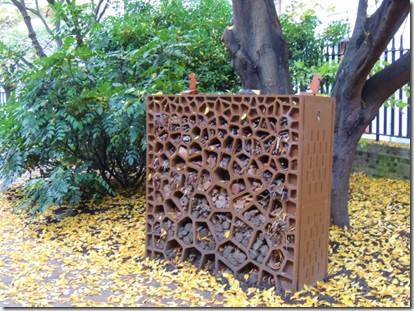
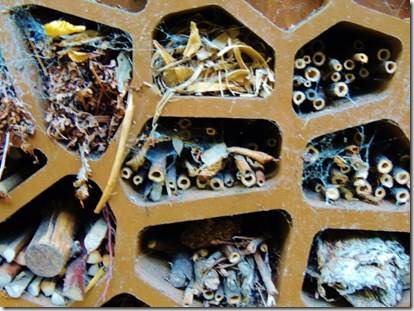
|
|
The Wren Clinic
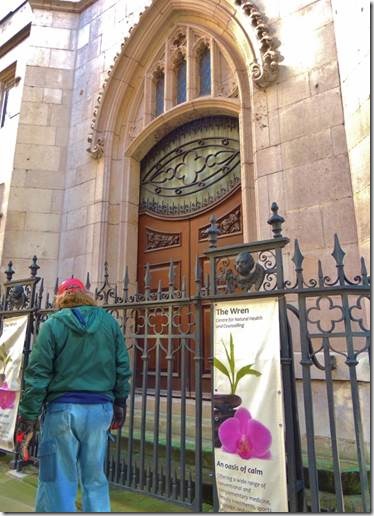
The Wren Clinic, EC3
Hello and welcome to the Wren. Approaching our 21st year, we are one of the longest established complementary health clinics in the City of London. Our practitioners are all highly trained, have generally been qualified and in practice for more than three years, and many of them are involved in coaching and teaching.
Address: Idol Lane London, London City of EC3R 5DD
http://www.wrenclinic.co.uk
Therapies:
Acupuncture, Alexander Technique, Allergy Testing/Treatment, Aromatherapy, Beauty Therapy, Bowen Technique, Chinese Herbal Medicine TCM, Chiropody/Podiatry, Counselling, Cranio Sacral, Life Coaching, McTimoney Chiropractic, NLP Therapy, Nutrition, Osteopathy, Pyschotherapy, Reflexology, Reiki, Shiatsu, Sports Massage
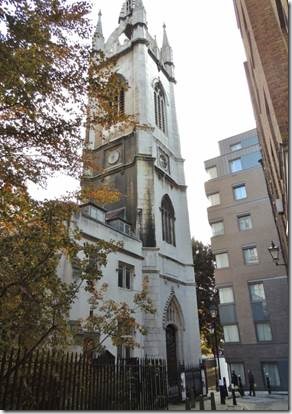
The Clinic is located in the building adjacent to the tower.
“Tower, 1698, by Wren. Large, Portland stone structure in gothic style. 3 main stages, Diagonal buttresses rising to octagonal turrets with large finials. Smaller finials between. Stone spire supported on open diagonal arches. Enriched doorways to west and south. North side now obscured by low building. East side rendered where formerly within church. Fine gates and railings to both doorways. Body of church, 1817-18, by David Laing. Destroyed except for walls in World War II. Gothic style with buttresses, traceried windows pinnacles etc. Yellow brick faced externally in Portland stone. North-east vestry. East wall reduced to sill level in centre.
Listing NGR: TQ3314980718
Selected Sources
Legacy Record – This information may be included in the List Entry Details
National Grid Reference: TQ 33149 80718
7 days a week throughout the year 8am – 7pm or dusk – whichever is earlier.”
http://list.english-heritage.org.uk/resultsingle.aspx?uid=1359173
|
Additional Information about the Church, the affiliated school that once had been here, and Saint Dunstan.
According to the plaque on the site, a church has been here from ancient times, with a large churchyard by 1193/4. In 1366 the church required rebuilding but the Archbishop had to compel parishioners to contribute to the costs. In 1417 it closed temporarily after a fatal brawl, and in the 1450s a school was set up in the church. The building suffered damage in the Great Fire of 1666, after which the shell of the church was repaired through a private benefactor by Christopher Wren in 1695-1701. Wren re-built the tower and steeple, possibly assisted by Nicholas Hawksmoor. The church was in a bad state by the early C19th and was later rebuilt in 1817-21 by David Laing, but it was destroyed by enemy action in 1941 and little survived although the spire was reconstructed in 1953 and the tower restored in 1970-72 by Seely and Paget Partnership for use as offices.
The Corporation of London had acquired the church ruins in 1967 and these and the former churchyard were incorporated into a well-designed garden on several levels, which includes a circular cobbled area with a central fountain. Unusual trees, shrubs, flowers and climbers grow among the ruined arches and tracery. It was the largest garden to be created by the Corporation of London in the City in the C20th and was opened by the Rt. Hon the Lord Mayor Sir Peter Studd on 21 June 1971. The walls, gates and railings to the churchyard are of the Wren period. The tower and adjoining All Hallows House are now used as a complementary medicine centre and form part of the parish of All Hallows by the Tower (q.v.).
In 2010 the City of London and British Land collaborated in ‘Beyond the Hive’, an architectural competition to celebrate the International Year of Biodiversity. The design brief called for proposals for ‘Insect Hotels’: ecologically sustainable and creative insect habitats, and resulted in five finalists. The winning entries were built during June 2010 in 5 public gardens in the City: Bunhill Fields, Cleary Garden, Postman’s Park, West Smithfield Garden (q.q.v.) and here in St Dunstan-in-the-East.
http://www.londongardensonline.org.uk/gardens-online-record.asp?ID=COL068
The Church
This medieval church was devastated with bombs in World War II, leaving the interior just an empty shell.
But the ruins and the Wren Tower have become dramatic frames for the imaginative planting of wall shrubs and climbers.
This is an extraordinary example of a small space in the City, which makes the maximum use of scarce resources.
The City of London Architects and Parks Departments won a Landscape Heritage Award in 1976 for their imaginative work off Roehampton Lane.
This green oasis is busy on weekday lunchtimes with office workers eating their lunches, but becomes eerily quiet at weekends. http://www.bbc.co.uk/england/sevenwonders/london/city_gardens/
Related church history from St. Dunstan College
The Foundation has its origins in the parish of St Dunstan-in-the-East, established on St Dunstan’s Hill in the City of London.
A Christian church has probably stood on this site since the Roman occupation. The oldest remaining written record dates from 1272, the vestry "Grete Book", having been lost in the Fire of London.
In 1446 a writ of Privy Seal addressed to the Chancellor, stated that the Archbishop of Canterbury and the Bishop of London,
‘considering the great abusions that have been of long time within our citee of London that many and diverse person not sufficiently instruct in gramer presumynge to hold comune grammer scholes, in great deceipte as well unto theire scholers as unto the frendes that fynde them to schole’, had ‘of their great wisdome set and ordeigned five scholes of gramer and no moo, one within the church yard of St Pauls, a second at St Martin Le Grande, another at Bow Church in Cheapside, another at St Dunstan-in-the-East and the fifth at the Hospital of St Anthony’.
The Chancellor was ordered to "Command all lige subjects not to trouble or impeche the maisters of the said scols, but rather helpe and assiste inasmoch as in them is."
By 1865 it was agreed to use the majority of the endowments of the parish to provide a new school on parish land elsewhere. "Owing to the enormous prices of London ground suitable and the very signifcant tendancy of large London schools to move out from the centre, the school should be placed at such a convenient distance from London as to be accessible by railway and that it should therefore be built on the Charity Estate at Catford Bridge in the Parish of Lewisham contiguous to a station on the Mid-Kent-Line of the Southeastern Railway Company, whereby proper play grounds would be secured for recreation and the remaining portion of the estate very greatly improved for building purposes…to engage first class talent in Masters and to supply First-Class education to the pupils adapted to the circumstances and the wants of the present day". http://www.stdunstans.org.uk/history
Saint Dunstan
BY DAVID ROSS, EDITOR
At A Glance
•Bishop of Worcester
•Archbishop of Canterbury
•Patron saint of: Armourers and gunsmiths
•Born 909; Died May 19, 988
•Feast Day: May 19
•Symbol: smith’s tongs, and a dove
Saint Dunstan is fairly unusual among Anglo-Saxon saints in that we know where, if not precisely when, he was born. Dunstan was born in the village of Baltonsborough, Somerset, just a few miles south of Glastonbury, probably about the year 909 or 910. [Note: the Anglo-Saxon Chronicle gives the birth date as 925]. His father Heorstan was a Wessex nobleman of royal blood, and his family connections were to be of great benefit to him in his later career in the church. Glastonbury was at that time a popular place for Christian pilgrimage; folk traditions told that it was the first place of Christian settlement in Britain, and associated it with Joseph of Arimathea and Jesus himself.
Glastonbury Abbey
The Abbey at Glastonbury was a centre of learning, and housed scholars from as far away as Ireland. The young Dunstan was educated at Glastonbury and then joined his uncle Athelm, Archbishop of Canterbury, at the royal court of King Athelstan.
Dunstan took to the monastic life much later than most; taking holy orders in 943, when he may already have reached 34 years. Apparently he was at first disinclined to a life in the church, but a skin disease which he feared might be leprosy made him change his mind.
After taking orders Dunstan returned to Glastonbury and built himself a small cell (i.e. a hut) beside the Abbey church. There he lived a simple life of manual labour and devotion. He soon showed great skill in the arts of metalworking, and he used his skills to craft bells and vessels for the church.
But his life was not to stay simple for long; Athelstan died, and his successor Edmund called Dunstan to his court to act as a priest. After a short period at court, Edmund named Dunstan Abbot of Glastonbury.
So once more Dunstan returned to the place of his birth, this time on a mission to reinvigorate the abbey. He instituted the strict Benedictine Rule, rebuilt and enlarged the church buildings, and established Glastonbury as a leading centre of learning and scholasticism. The effect of Dunstan’s reforms, and in particular his efforts to produce a class of educated clerics, did much to encourage the growth of monastic settlements throughout Britain.
Dunstan acted as a royal advisor and negotiator for Edmund and his successor Eadred, and helped establish a period of peace from Danish attack. Unfortunately in 955 Dunstan’s zeal got him into trouble when he reproved young King Eadwig for moral laxity. Eadwig promptly confiscated Dunstan’s property and exiled the monk.
Dunstan found shelter at the monastery of Ghent, in modern Belgium, but he was quickly called back to Britain by Edgar, king of Northumbria and Mercia.
Edgar shared Dunstan’s monastic zeal, and together they put considerable energy into monastic reform and expansion. Under Edgar’s influence Dunstan became Bishop of Worcester, and when Eadwig considerately died in 960, Dunstan was named Archbishop of Canterbury.
In this post Dunstan carried on his work of encouraging scholarship and monastic settlements. He also oversaw every detail of Edgar’s coronation as king.
It is said that he designed the coronation crown himself, and more importantly, that he altered the ceremony to put emphasis on the bond between church and monarch; making the coronation a sacred act, emulating the ceremony of consecration for priests. Dunstan’s coronation ceremony still forms the basis of royal coronations today.
When Edgar died, Dunstan carried on as advisor to his son Edward, but when Edward was murdered in 978 to make way for his brother Ethelred, Dunstan retired from court life. He lived on at Canterbury, delighting in teaching the young and only rarely troubling to involve himself in the politics of the realm.
When he died in 988 Dunstan was buried in his cathedral, where his tomb was a popular place of pilgrimage throughout the Middle Ages. Until Thomas a Becket later eclipsed Dunstan’s fame he was the most popular English saint. http://www.britainexpress.com/History/saxon/dunstan.htm
“Our historic home” from the Wren Clinic website with some interesting tidbits about St. Dunstan
By admin, on December 13th, 2012
Is attributed to Sir Christopher Wren, the King’s Architect, but was possibly designed by Robert Hooke, Surveyor to the City of London – the first person to demonstrate an artificial lung, blood transfusion and the modern model of memory.
St Dunstan’s in the East was built following the Great Fire of London. A church was first built on this site in Saxon times, and was restored by St Dunstan in 950. The mediaeval church was destroyed during the Great Fire of London in 1666, which started only four streets away in Pudding Lane. St Dunstans was rebuilt between 1697 and 1702. Only the tower remains of the ‘Wren’ church.
The body of the church was demolished and rebuilt by David Laing in 1817 in the gothic revival style.
St Dunstan’s was badly damaged in 1941 during the Blitz of World War II. The restored tower also retains a consecrated chapel in which services can be held. The walls of the nave were left standing, within which the City Corporation have created a beautiful garden with seating and a fountain for visitors.
St Dunstan
St Dunstan was born near Glastonbury early in the tenth century and lived during a period of monastic revival after the defeat of the Danes. While a Benedictine monk at Glastonbury, he became skilled in the crafts, particularly metalwork, which may explain why the Goldsmiths’ Company chose him as its patron saint. Besides being an accomplished musician and illuminator, Dunstan was also reputed to have been interested in science, concocting brews liable to explode! This possibly gave rise to the legend of his meeting with the devil, whose nose he is said to have seized with a pair of tongs.
Hence the tongs borne by sculptured angels over the altar of the Chapel of Ease on Idol Lane.
St Dunstan was made Abbot of Glastonbury in 940 and from 960 when he became Archbishop of Canterbury, he exercised great influence over King Edgar and his court. He was canonised shortly after his death in Canterbury in 988. http://www.wrenclinic.co.uk/2012/our-historic-home/
( I didn’t know about the sculptured angels or the Chapel of Ease, so one day I’ll go back and see if I can find them.)
A quirky story about St. Dunstan from a person named Sarah Boulton
On 19th March 2013 I attended an appointment under the name Isabelle Boulton at the Wren Clinic, a health and nutritional centre based in the bell tower of 11th Century church, St Dunstan in the East.
In 1970, the bells were removed from this bell tower. The former bells are said by many to have rung out the most beautiful sound of all the churches in London. After months of attempting to find a ‘live’ partner church – whose bells I might record to make into a sonic gift for St Dunstan – as well as gaining permission to then play this gift inside the bell tower (or at least even just the into the gardens!), i was met with a resounding ‘no’.
Eventually I found a sound recording made in 1970: on the very last day that the bells were installed in their tower. So I set this as my phone’s ringtone, entered into the Wren Clinic with my phone in my coat pocket, climbed to the top of the stairs and hoped that my phone might ring http://www.sarah-boulton.co.uk/

